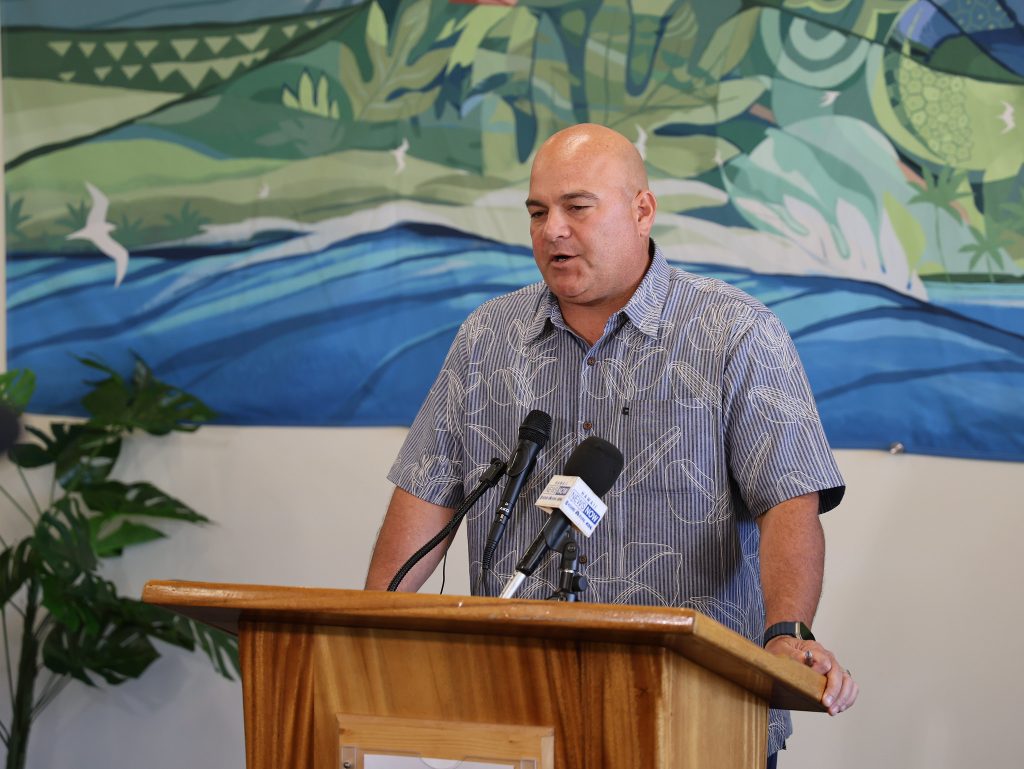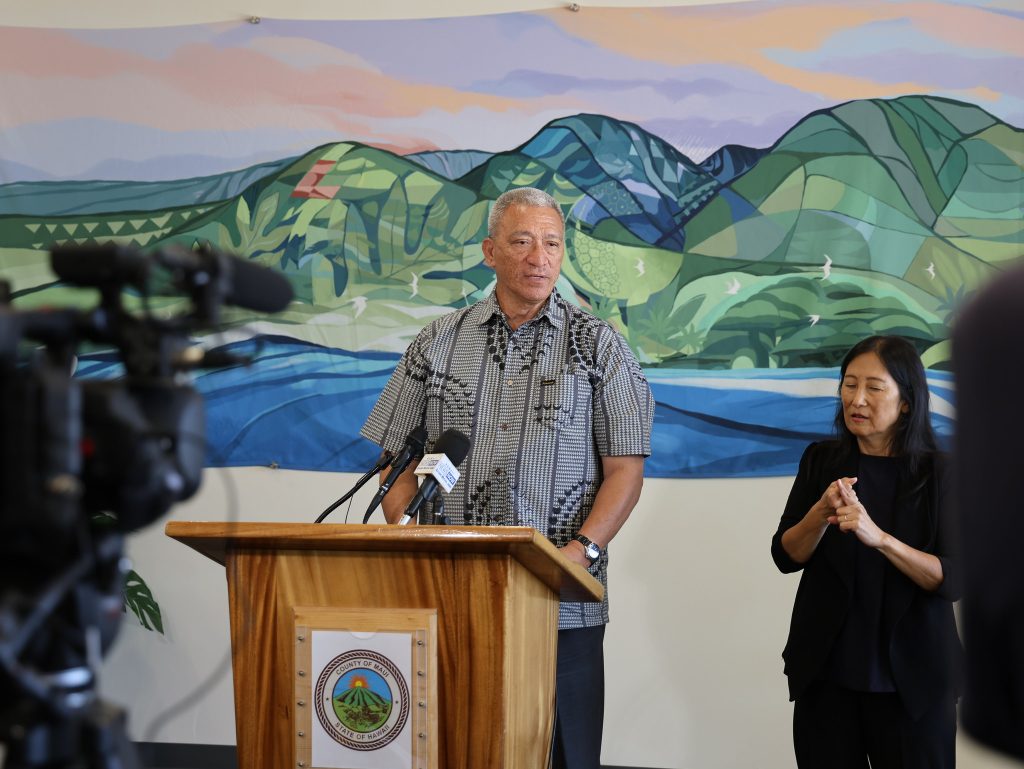Maui wildfires one year later: state, federal and local authorities recap recovery

*VC: by Wendy Osher
After marking one year since devastating wildfires swept through West Maui and Upcountry, state, county and federal leaders gathered to recap response and ongoing recovery. The fires destroying the town of Lahaina, claiming the lives of 102 people and leaving thousands displaced. The process toward recovery is ongoing with housing of wildfire survivors remaining a key focal point.
Gov. Josh Green, M.D., reflected on the year since the disaster, saying: “One year ago, the wildfires in Upcountry and West Maui brought unprecedented tragedy, but it also revealed the incredible strength and resilience of our community. We honor the 102 lives lost and the two people still missing, and we extend our deepest gratitude to the first responders and volunteers who stood up in our great time of need. The recovery journey has been challenging, but through our collective efforts, we have made significant strides. Together, we are restoring not just homes, but also hope and community. Mahalo to everyone who has contributed to this recovery effort.”
Maui Mayor Richard Bissen said progress is being made and that recovery work is further along than anticipated as the one year mark passes.
“Drinking water was restored just one week ago, sewer infrastructure should be restored by the end of the year and we are starting to see homes going up. We have 50 permits issued, 111 in the queue and 16 houses are actively being built. Residential debris removal is almost complete and we are making great headway with commercial property clearances. This momentum continues to give our community hope. None of this would have been possible without the unwavering support of federal, state and nonprofit partners, as well as our local and county workforce, which we are incredibly grateful for,” said Bissen.
In response to the disaster, state agencies collaborated with Maui County, FEMA and the Red Cross to provide essential support, including meals, temporary housing and various services. Organizations like the Hawai‘i Community Foundation and the Council for Native Hawaiian Advancement played a crucial role in mobilizing donations, contributing tens of millions of dollars to the relief efforts.

Efforts by the US Army Corps of Engineers to clear fire ash and debris from 1,399 fire-damaged residential properties on Maui have been substantial. As of Friday, 98% of residential lots have been cleared of debris, with the goal of returning all these properties — clear of debris and ready for the next steps in rebuilding — to their owners by the end of the year. State officials say this progress is months ahead of the 12-month long mission forecast. Commercial property debris clearance is also well underway, with nearly 50% of the 159 properties cleared of debris.
“Our progress over the past year reflects the unwavering spirit and resilience of the Maui community,” said USACE Hawai‘i Wildfires Recovery Field Office Commander Col. Eric R. Swenson. “From constructing a temporary school campus to clearing properties for our Maui friends and families to begin rebuilding on their properties, we are committed to supporting the community’s reemergence.”
During the past year, USACE has awarded contracts valuing a total of $408 million dollars to local and Native Hawaiian-owned small businesses. Officials say this has ensured that recovery efforts support the local economy.

“In the face of immense loss, the Maui community has shown tremendous resolve and resilience that has inspired the nation. Maui has taught us all what it means to come together to rebuild and heal as a community,” said FEMA Administrator Deanne Criswell. “On this road to recovery we’ve witnessed true compassion — neighbors helping neighbors and a groundswell of support from not only across the island, but across the state and the nation. FEMA will continue to be here for as long as it takes to recover, rebuild, and create the more resilient Maui that this community needs and deserves.”

“This week we reflect on the tragic fire in Lahaina and remember those lost, and we do so with great hope in our hearts.” said US Fire Administrator, Dr. Lori Moore-Merrell. “I hope that never again will this island or any other community suffer such great loss due to fire. The US Fire Administration has worked with Maui County Fire Department, and HI-EMA to ensure new technology is leveraged for sensing future ignitions quickly and is working to bolster the capacity of firefighter response by training interagency all-hazard incident management teams. As the build back continues, we encourage residents to build fire-resistant homes and maintain fire safe actions so that Maui’s people don’t just survive, but also flourish in this environment.”
The Department of Homeland Security Science and Technology Directorate announced the placement of 80 wildfire detection sensors across Maui and across the islands. The department installed these sensors, which use state-of-the-art technology to detect the early stages of wildfires for operational testing and evaluation. Having successfully completed that testing, the sensors’ installation and functioning marks a significant milestone in the state’s resilience efforts, one year after the devastating wildfires.

“Our installation of advanced wildfire sensors across the Hawaiian Islands marks a significant step forward in helping ensure communities are resilient and better protected against future fire threats,” said DHS Under Secretary for Science and Technology, Dr. Dimitri Kusnezov. “These sensors will provide early detection and rapid response capabilities, helping to prevent such devastating events from occurring again.”
The Maui Recovery Fund was established to provide rapid financial assistance to affected families. In the last year, more than $1.8B in federal support has been provided for the immediate response for housing survivors, debris removal, temporary school and other disaster services. The state has expended $500M as part of the state cost share as well as construction of temporary housing. In total, over $2.3B has gone toward the response.
FEMA registered more than 17,000 survivors, providing more than 18 months of rental assistance. The Maui Interim Housing Plan aims to create more than 3,000 housing units for displaced families. Currently, over 99% of those displaced have been moved into long-term housing.
New housing developments, including Ka La‘i Ola, Ke Ao Maluhia at Maui Lani and La‘ikū along Lahainaluna Road, among many others, have started to house displaced families. Additionally, the construction of 810 new permanent housing units and 1,044 transitional housing units is underway. This construction is possible only through collaborative efforts of the state, county, federal government, philanthropic and nonprofit partners.
“The Maui community has shown incredible strength and resilience over the past year and we continue to stand ready to support them,” said Micah Kāne, CEO and president, Hawai‘i Community Foundation. “As we look forward to the next phase of recovery, a key priority is to address the unaffordable housing system, and with the same cross-sector collaboration that was required to execute on the Maui interim housing plan. It’s not an option to let the continued broken housing system persist.”
“One year after the fire, we remain committed to supporting and uplifting our Lahaina and Kula ‘ohana, remembering both challenges and triumphs, acts of kindness and resilience — and we’ll remain steadfast to kāko‘o Maui,” said CNHA CEO Kūhiō Lewis.
USACE built a new temporary school campus for displaced Lahaina students near Kapalua Airport in just 95 days — and the new Kaiser Permanente Lahaina Clinic was built and opened within nine weeks to provide essential health care services.
In April, plans to renew Moku‘ula, a site of profound cultural and historical significance, were announced. The transfer of related state land to the county was officially signed by Governor Green on Wednesday. The restoration of Moku‘ula symbolizes resilience and dedication to preserving Maui’s heritage and cultural importance.



















